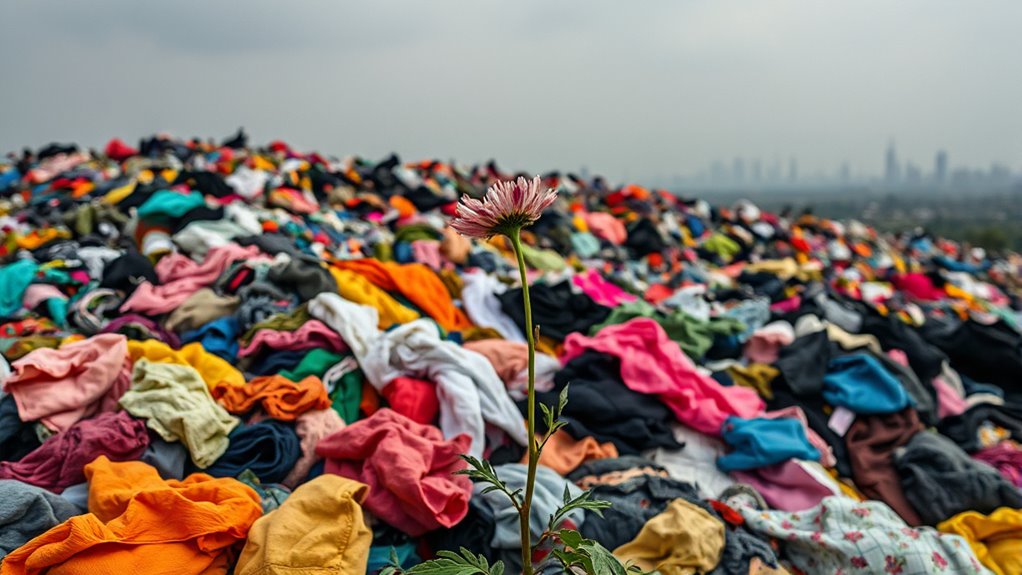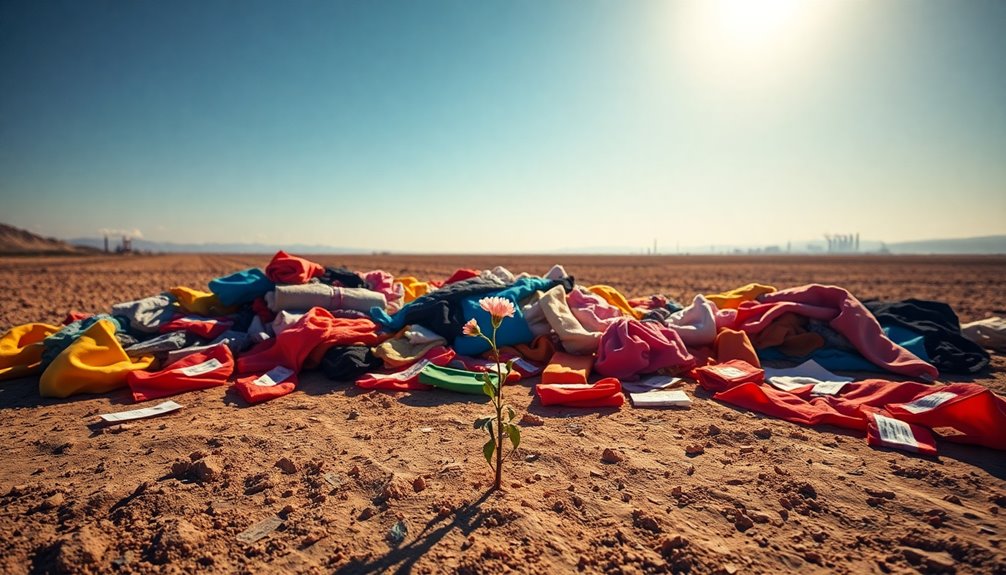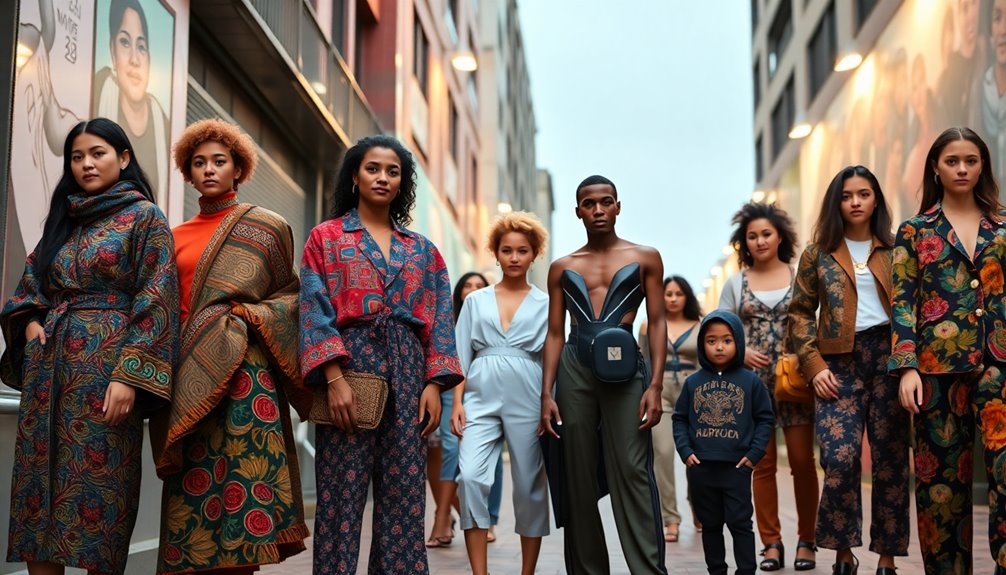Fast fashion’s impact on the planet is enormous. It generates about 10% of global CO2 emissions, more than all international flights and shipping combined. The industry also uses a staggering 93 billion cubic meters of water annually, polluting sources with harmful chemicals. Plus, it produces around 92 million tons of textile waste each year, with most ending up in landfills. Understanding these issues can help you make more sustainable choices. There’s more to discover about these pressing problems.
Key Takeaways
- Fast fashion accounts for about 10% of global CO2 emissions, surpassing emissions from international flights and shipping combined.
- The industry is the second-largest consumer of water, using approximately 93 billion cubic meters annually, stressing vital water resources.
- Responsible for 20% of global wastewater, fast fashion pollutes water bodies with harmful chemicals from dyeing processes.
- Approximately 92 million tons of textile waste is generated each year, with 85% ending up in landfills, highlighting significant waste management issues.
- The economic model of fast fashion promotes disposable trends and resource exploitation, perpetuating a cycle of environmental degradation.

As the fashion industry churns out new styles at an alarming rate, you mightn’t realize the profound impact fast fashion has on our planet. Every time you grab that trendy shirt or those cute shoes, consider that fast fashion contributes about 10% of global CO2 emissions. That’s more than international flights and maritime shipping combined! This staggering number reflects the industry’s extensive supply chain, which churns out greenhouse gases from production to transportation.
Water is another critical resource affected by this model. The fashion industry is the second-largest consumer of water, using around 93 billion cubic meters annually. To put that in perspective, producing just one cotton shirt requires about 2,700 liters of water—that’s what one person would drink in two and a half years.
The fashion industry consumes 93 billion cubic meters of water yearly—enough to meet one person’s drinking needs for two and a half years with just one cotton shirt.
With such high consumption, it’s no wonder that fast fashion is responsible for 20% of global wastewater, often contaminated with harmful chemicals from dyeing processes. Factories often dispose of untreated wastewater directly into rivers and oceans, leading to significant water pollution that harms aquatic ecosystems.
The economic costs of fast fashion also play a role in its environmental impact. By relying on cheap materials and labor, the industry keeps production costs low, but at the expense of the environment. This model encourages you to buy more frequently, leading to higher overall spending, even if individual items seem affordable.
The rapid production cycles mean that about 15% of fabric used in garment manufacturing becomes waste, contributing to the staggering 92 million tons of textile waste generated globally each year. Alarmingly, this figure could rise to 134 million tons by 2030 if trends continue.
The impact doesn’t stop there. Fast fashion’s influence on consumer behavior promotes a cycle of disposable fashion trends, where items are quickly discarded rather than cherished. Currently, around 85% of textile waste ends up in landfills, with only a small percentage recycled.
This waste not only takes up space but also contributes to greenhouse gas emissions as it decomposes.
Frequently Asked Questions
How Can Consumers Reduce Their Fast Fashion Consumption?
You can reduce your fast fashion consumption by opting for thrift shopping, supporting sustainable brands, and exploring clothing rental services.
Try swapping clothes with friends or building a capsule wardrobe to minimize purchases.
Additionally, wash your clothes at lower temperatures and consider repairing items instead of discarding them.
Donate or sell unwanted clothing to extend its life, and focus on buying fewer, higher-quality pieces to make a positive impact.
What Are Ethical Alternatives to Fast Fashion Brands?
Imagine you’re in a retro thrift shop, surrounded by unique finds. Instead of fast fashion, you can choose ethical alternatives like Everlane, which focuses on transparency, or Reformation, known for sustainable practices.
Brands like Nisolo and Veja offer stylish, eco-friendly footwear. Support companies that use recycled materials or certified organic cotton, and consider options like Girlfriend Collective for affordable, sustainable clothing.
Your choices can make a real difference in promoting ethical fashion.
How Does Fast Fashion Affect Workers’ Rights Globally?
Fast fashion severely undermines workers’ rights globally.
You’ll find that many garment workers endure unsafe conditions, long hours, and meager wages, often below a living standard.
Child labor and forced labor are rampant, leaving countless individuals vulnerable to exploitation.
As a consumer, your choices can impact these workers’ lives, pushing brands towards more ethical practices.
Advocating for fair wages and better working conditions can help empower those affected by this industry.
What Role Does Social Media Play in Fast Fashion Trends?
Social media plays a huge role in shaping fast fashion trends. You see influencers showcasing the latest styles, making it easy to adopt new looks quickly.
Platforms like TikTok create viral trends, pushing you to keep up with the rapid pace. You might feel pressured to participate in haul culture, buying more than you need.
The constant stream of content can overwhelm you, driving impulsive purchases and encouraging a cycle of overconsumption.
Are There Regulations Against Fast Fashion Production Practices?
Regulations against fast fashion production practices are popping up like wildflowers in spring.
You’ll find international laws, like France’s “anti-fast fashion law,” aiming to curb harmful practices. In the U.S., the FABRIC Act pushes for fair worker rights and lower emissions.
States like New York are demanding transparency from brands about their environmental impacts. These efforts represent a growing recognition that change is essential for a more sustainable fashion industry.
Conclusion
In a world where we can’t imagine life without instant gratification, the fast fashion industry serves up trendy clothes at breakneck speed, but at what cost? You’ve seen the overflowing landfills and polluted waters, and it’s time to take a stand. By choosing sustainable options and supporting ethical brands, you can help reverse the damage. Remember, every little choice adds up, and together, we can stitch a brighter future for our planet. Let’s make fashion work for the Earth, not against it.










